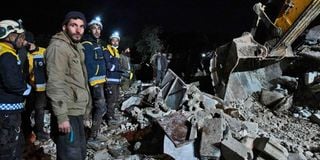Earthquakes explained: What you should know about Turkey, Syria disaster

Members of the Syrian civil defence, known as the White Helmets, work at the rubble of a collapsed building late on February 7, 2023, in the town of Jandairis, as search and rescue operations continue following a deadly earthquake.
Emergency aid from across the world, including Kenya, is pouring into Turkey and Syria following a devastating earthquake of biblical proportions.
It is a race against time to save the lives of survivors of the magnitude 7.8 quake that has so far claimed more than 9,500 lives.
The disaster has drawn global attention to the natural phenomena characterised by violent shaking of the ground as a result of sudden movement of rock materials below the earth's surface.
- But really, what is an earthquake?
Also known as a quake, an earthquake is the shaking of the surface of the earth resulting from a sudden release of energy in the earth’s lithosphere that creates seismic waves.
According to the United States Geological Survey (USGS), a website that provides details about the natural hazards that threaten lives, earthquakes range in intensity— from those that are so weak to be felt, to those that are so violent that in their aftermath, are casualties like is the case in Turkey and Syria.
- What causes earthquakes?
On the earth’s surface, earthquakes manifest themselves by shaking and displacing or disrupting the ground, geologists say.
The tectonic plates are always slowly moving, but they get stuck at their edges due to friction. When the stress on the edge overcomes the friction, USGS explains, there is an earthquake that releases energy in waves that travel through the earth's crust and cause the shaking that we feel.
The seismic activity of an area is basically the frequency, type, and size of earthquakes experienced over a particular time period.
The seismicity at a particular location in the Earth is defined as the average rate of seismic energy release per unit volume.
- How is the intensity measured?
Earthquakes are measured by their magnitude, which is set up as a logarithmic scale ranging between zero and 10.
Each whole number represents a tenfold increase in strength. The most powerful quake on record is a 9.5-magnitude one that struck Chile in May 1960.
- What is the difference between an earthquake and a tremor?
While they are both signs of seismic movement within the earth, the difference is the intensity of the movement.
Earthquakes, geologists say, are more intense than earth tremors. When a tremor exceeds five on the moment magnitude scale, it is referred to as an earthquake.
The word tremor is also used for non-earthquake seismic rumbling, researchers say.
- Is it possible to predict earthquakes?
While some people may argue that the use of technology such as computing power, mathematical models, drones, satellite— including the use of artificial intelligence— as has been used in enhancing weather forecasting, may help predict occurrences of earthquake, geologists says it almost impossible to perfectly predict a quake because of the complexity of analysing the entirety of the planet’s crust.
“An earthquake happens very, very quickly. It’s fair [to say] that at this point, we are not capable of predicting earthquakes at all,” Christine Goulet, director of the USGS Earthquake Science Center, told The Washington Post.
There is an element of randomness to how and when earthquakes happen. They sometimes happen without warning signs, experts say.
- At what depth do earthquakes occur? What is the significance of the depth?
Earthquakes, according to USGS, occur in the crust or the upper mantle, which ranges from the Earth’s surface to about 800 kilometers deep.
- Can humans cause earthquakes? Is there any way to prevent earthquakes?
Earthquakes can be induced by a wide range of causes, including impoundment of reservoirs, surface and underground mining, withdrawal of fluids and gas from the subsurface, and injection of fluids into underground formations.
And yes, earthquakes can be induced by human activity— and these have been documented in many countries. Man-made earthquakes’ effects, however small/little, are just as devastating as the natural one.
The US Geological Survey report indicates that the hazard posed by man-made earthquakes can be mitigated by minimising or in some cases stopping the activity that is causing the earthquakes to occur.
“We cannot prevent natural earthquakes from occurring but we can significantly mitigate their effects by identifying hazards, building safer structures, and providing education on earthquake safety. By preparing for natural earthquakes we can also reduce the risk from human induced earthquakes,” the USGS notes.
- What should one do after an earthquake has happened?
According to USGS, after the main quake, there are usually aftershocks that may occur hours, days or weeks later. These aftershocks may damage buildings and the resulting debris may injure people and animals.
Due to the disastrous nature of earthquakes, they can damage gas lines. It is therefore advisable to avoid open flames in damaged buildings.
At the scene, avoid using lighters and matches. If you happen to live near the coast, stay away from it since most of the time, the earthquakes cause flooding and even more disastrous tsunamis.
And, when you have to drive, use alternative routes to get to the same destination, USGS advises. Damaged structures and traffic lights may make it difficult to get to the destination.
- How can you stay “safer” during an earthquake?
Scientists advise individuals to stay calm, not to panic but to brace up and face whatever comes with courage as you look for safety.
It is best to stay in an open space, away from trees, power lines, or bridges. If you’re indoors, emergency rescuers advise: Drop to the ground and place your hands over your head and neck and crawl to safety under heavy furniture, say a table.
Even so, avoid the kitchen area, shelves, windows since the shaking is likely to shatter window panes or move dangerous objects that could harm you as you look for safety.





